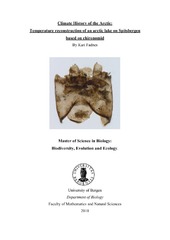Climate History of the Arctic: temperature reconstruction of an arctic lake on Spitsbergen based on chironomid
Master thesis
Permanent lenke
http://hdl.handle.net/1956/4222Utgivelsesdato
2010-06-01Metadata
Vis full innførselSamlinger
Sammendrag
ABSTRACT. The increase in global climatic changes seen in recent years is debated to be a result from expanding anthropogenic activity. The aim for the study is to contribute to the climatic history at western Spitsbergen mainly focusing on the last 2000 years and recent climatic events. Palaeoecoloogical studies investigates the climatic history of the past, assessing the speed and direction of future climate changes, and suggest how much of the changes are man made or based on natural forces. Chironomids are a good indicator for temperature changes in the past and were in this study used for a temperature reconstruction in lake Tjørnskardet on western Spitsbergen. The sediment cores were dated back to ~ 6000 years BP. From the chironomid assembly, a temperature reconstruction was established based on reduced modern training set. A total of 26 taxa were found, with Micopsectra, Hydorbaenus and Oliviridia showing a considerable higher abundance compared to the rest of the taxa in the assemblage. The inferred temperature based on full modern training set and the reduced training set were compared to the results from the neighbouring lake, Skardtjørna together with the chironomid assemblage. The reconstructed temperature gradient shows an overall temperature decline from ~ 6000 years BP to present, in correspondence to Skardtjørna and other sites at Svalbard. Some major aberrant trends in the results indicate that there might be a strong correlation between the temperature and other environmental variables, which will influence the chironomid composition and weaken the reconstructed temperature. The comparisons of the temperature from the training sets reveal that the inferred temperature based on the full training set showed more resemblance between the lakes.
Utgiver
The University of BergenOpphavsrett
The authorCopyright the author. All rights reserved
